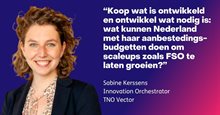These 100 net-zero cities do not have long to achieve energy neutrality, as they have to reduce their net greenhouse gas emissions to zero by as early as 2030. That’s a major challenge. How, in such a relatively short time, do you come up with an action-oriented approach, together with all stakeholders, that delivers results with sufficient speed?
Globally, more than 70% of CO2 emissions come from cities. Meanwhile, urbanisation is continuing at a rapid pace – in Europe too. Three quarters of EU residents are now city dwellers, for example.
Cities have traditionally been the driving force behind knowledge development, innovation, and new technology. They are therefore the perfect places to accelerate advances in the area of sustainability. For this reason, in 2021, the European Commission called on EU cities to sign up as net-zero or climate-neutral cities, with the aim of achieving climate neutrality by 2030.
More applications than expected
This ambitious mission met with an enthusiastic response: 377 cities from EU Member States took up the challenge. This was more than expected, which was obviously an encouraging sign. However, to keep the project manageable, a selection was then made. In the spring of 2022 the European Commission announced the 100 EU cities that would be participating in the mission and aiming to become climate-neutral cities by 2030. These are cities that have a clear link to the EU.
In the Netherlands, seven cities are involved: Amsterdam, Rotterdam, The Hague, Utrecht, Groningen, and Eindhoven & Helmond (these two cities are working as partners). There is at least one participating city in every EU Member State.
Learning from each other’s mistakes and successes
Now that the participating net-zero cities have been selected, the real work begins. An initial assessment revealed that there are significant differences between the cities taking part. ‘We can see that cities in Spain and Scandinavia are well ahead of the rest, for example. There is a lot that they can share with the other cities,’ says Tess Tjokrodikromo. At TNO she is conducting research into an integrated approach to the challenges and transitions facing society.
Tess is now sharing the knowledge she has acquired in this field with the cities participating in the NetZeroCities mission, by helping to organise events and develop digital tools, for example. ‘It’s important that participating cities have up-to-date information and can let each other know quickly and easily what works and what doesn’t. This will help the net-zero cities learn from each other’s mistakes or successes.’
A strong movement towards climate-neutral cities
The European Commission is keen to create a snowball effect with this project. Good knowledge sharing is essential for that. ‘We are expecting a lot from the digital platform that is currently being developed and to which we are also contributing,’ adds Geiske Bouma. Her research interests at TNO include urban innovation, climate-neutral cities, and smart cities.
‘In addition, we are also supporting the participating cities in other ways. We are helping them draw up a good Climate City Contract, for example. This is a contract that clarifies the agreements that all parties within a city make with each other with a view to becoming a climate-neutral city by 2030. It’s not just a question of creating commitment within government, businesses, and civil-society partners, but also, above all, of actively involving citizens. Drawing up and signing a contract like this is often a surprisingly useful way of starting a strong movement.’
Refining agreements
Like Bouma, Tjokrodikromo also frequently examines initial versions of urban climate contracts.
‘At TNO Vector we are mainly concerned with governance issues and mutual learning and exchange within the NetZeroCities project.
And because we have taken on the reflective monitoring of climate contracts, we get a good insight into these aspects right from the start. If the agreements are still too vague or too non-committal, we coach cities to help them refine them.’ We do this mainly by asking questions and exploring possible solutions:
- What actions are planned?
- What parties are involved in the actions and how?
- What are the timelines?
- Are you on track to actually become a climate-neutral city by 2030?
Every city presents its own challenges.
‘We’re not going to write the climate contracts for them,’ Bouma explains. ‘Our role is limited to providing knowledge and expertise that helps cities achieve the necessary acceleration, in relation to both technological and societal innovations. We also organise regular webinars on specific topics and there is at least one physical meeting every year attended by representatives from all selected cities. It’s at these times in particular when you notice that they’re all at different stages and each city is facing its own challenges.’
Different emissions, different cooperation partners
The type of challenge is largely determined by the character of a city. Is it a port city? Does it have a lot of industry? Or is it a city in the middle of a rural area? That makes quite a difference to the type and amount of emissions a city has to deal with, and also to the partners you need to work with to reduce those emissions to zero. But that does not mean that cities have to reinvent the wheel every time. Cities with similar characteristics can learn a lot from each other. Within the EU much is already being done in the area of Smart Cities, which has a great deal of overlap with the NetZeroCities mission. So it is important to create a good connection to this field too.
A national support structure helps
Another key consideration is how active the national government is when it comes to sustainability. Bouma: ‘In some countries you see that the city council of an ‘EU Mission City’ is participating wholeheartedly in the NetZeroCities project, while the national government is still much less focused on sustainability and offers little support. On the other hand, you have countries like Spain and Sweden, where all levels of government work well together and there really is a national support structure in place. That structure allows cities in those countries to learn from each other faster and also to scale up successful approaches more quickly.’
Such a support structure is now being developed in the Netherlands too. Bouma: ‘The best advice you can give cities that want to become a net-zero city is to properly involve all layers of government in the plans. This ensures that government policy does not hold you back, but actually works in your favour.’
The role of local politics in the EU Cities Mission
‘Changes in local politics can also present a challenge,’ adds Tjokrodikromo. ‘The political colour of a city council clearly affects the latitude officials have when making plans to achieve a climate-neutral city. And, of course, the issue should not suddenly find itself much lower down the political agenda following local elections. Jointly drafting and signing an urban climate contract therefore plays an important role in this area too. It means the EU Cities Mission is not just a matter for local politicians, but a shared responsibility, with all parties in the city who have committed to the mission having an important role to play. It’s therefore a good way of developing support and ensuring the issue is firmly fixed on the agenda for the long term.’
Living up to high expectations
NetZeroCities has grown into a very large project in just a short space of time. Two follow-up projects are now also being prepared, which will scale up the project significantly – to other cities, as well as in terms of the depth of focus on topics. So it will only get bigger and more complex. And that shows how serious the European Commission is about it, all in the belief that cities have enough innovative power and capacity for change to really make a difference. It is now up to the selected 100 cities to live up to those high expectations. They have seven years to go.




